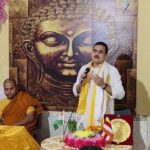Narendra Modi: Creative Disruptor
- By : Anirban Ganguly
- Category : Articles

Narendra Modi – creative disruptor: the maker of New India (Konark Publishers, 2019) by veteran journalist and public intellectual Dr R Balashankar, is the right antidote to another book on Modi, written by another Malayalee, who often falsely claims to be a “good Hindu” – Dr Shashi Tharoor. Anyone who has had the misfortune of expending energy by going through Tharoor’s nefarious opus, The Paradoxical Prime Minister: Narendra Modi & His India, would do well to detoxify themselves, cleanse their intellectual spaces and reboot their faith in India by reading Balashankar’s inspiring opus on Modi. The book is, as Arun Jaitley noted in the introduction, a “comprehensive study of the post-Congress polity of India since 2014” and “so far, no other book has presented the power shift so vividly and authentically” as has Balashankar’s book. In fact, his book is all about how Modi is gradually freeing India from the grips of a paradoxical mindset, a paradoxical political ideology and political culture as represented by Tharoor’s party.
While Tharoor’s book is a reflection of his convoluted and ideology-laced reading of Modi, a reading and examination that is in itself paradoxical, hollow, distorted, generalised and written to suit the requirements of the political dynasty that he serves and the party that he professes to be part of, Balashankar’s is an unbiased labour based on intense study, on minute and patient observation and years of analysis, displaying a mind which has an unceasing capacity to decipher, dissect, deliberate and then to articulate in a dispassionate manner. In short, Balashankar, while putting this together, has not attempted to serve any master, or any political line, he has passionately and yet empirically demonstrated in chapter after chapter, how Modi has and continues to work to put India back on track through demonstrable and visible change and transformation in terms of policy and governance.
The book is not a party document; though it is a work by a party man, it draws its own conclusion and perspectives. It is this which makes it even more credible, legitimate and worthy of examination. BJP president Amit Shah, in his foreword to the book, points at this crucial aspect when he writes that the analysis has been presented successfully, honestly and factually and that it is an “independent work and it is his [Balashankar’s] understanding of the political and economic scenarios of the country. The conclusions are his own and the party need not entirely agree with them.” But the importance of the book, as Shah argues, is that its “facts are not distorted and opinions are free from prejudices.” It is a book that comes “across as a sincere attempt to present a correct picture before the reader”.
For those among the uninitiated who possess a legitimate curiosity to understand the Modi phenomenon, who have, in the last five years, seen him at work, labouring away, toiling without respite, to lay the foundations and then erect the new structures for a new India, and want to know the origins, the evolution and the continuum of this phenomenon that burst forth on the national scene in May 2014, Balashankar’s book is the right shop to visit and to immerse themselves in. It is a new window, the latest window, to let us into the Modi saga, a saga of struggle, of grit, of determination and of self-excelling; a narrative that is “gripping, thrilling and inspiring”, as the author describes it. Modi, as the author reminds us, “is no accidental Prime Minister. He had to fight hard every inch so that he could survive the test. He had no pedigree.” It, therefore, makes the story even more interesting, convincing and inspiring.
But what is it that propelled the author to record this story? What is it that drove him to undertake the effort to draw a counter-narrative to the false narrative that a certain section is consistently trying to disseminate on Narendra Modi’s governance, vision and his performance as Prime Minister? The real narrative about Modi post-2014 could not be wished away, the story could not go unwritten, especially at a time when some out-of-work, sulking and out-of-post politicians are repeatedly indulging in sophistry while giving out their tinctured version of the new India story and of Narendra Modi’s current tenure as prime minister.
“Intellectual honesty and historic need” demanded that this story be narrated, especially at a time when “all efforts of no-changers and naysayers are to dismiss this is as a passing phase” by trying to entrench the attitude which says, “nothing will change, because we are here to stop any change”. This book is an answer to these naysayers, to these status-quoists; about them, the author says, “They have had their say. The nation gave them the stage for six decades. Really a long enough rope. But they want to keep the nation backwards. They want to keep people poor. They want their dynasties, perks and privileges intact while the people keep looking for silly doles and small mercies.”
On the other hand, Modi, overturned, disrupted the terms of the game, as well as the conditioning and mindset. He moved forward to “empower the poor. He made them realise their worth and fight for it” as a result, gradually, “the ones who were the underdogs of Indian society are now finding that their voice is being heard”, this has shattered the “established vested interests”. Modi is certainly “ushering in a new political possibility” and his story is also about these unfolding possibilities.
About Modi’s life, education, his life as an RSS pracharak, his struggle against the Emergency, his entry into politics and thereafter, much has been written, but that, as the author tells us, “is not the scope of this book” rather the main focus of the book is on Modi’s “road to power on the crest of a popular mandate, the circumstances leading to it” and, more importantly, “how he has been successful in redeeming his pledge to the nation”. It is a story that needs to be narrated and reiterated. Against a raucous and vocal section which has obsessively tried to “downsize and ignore Modi’s great achievements”, this book stands as a counter, it exposes the prejudices and the false portrayals resorted to by this section which is propped up by a political motive and agenda.
The Creative Disruptor, thus, is an interesting read, because it also analyses how Modi’s ascension, the new power shift in 2014 had “unnerved the entrenched political establishment. They did not know how to respond” because with Modi’s advent, his determination to take on the system, to dissolve and explode nexuses and syndicates, to eradicate entitlements and cronyism, they stared, in a sense, at the dismantling of their own empires of convenience.
In fact, as the author has rightly pointed out, the “biggest transformation that has happened after 2014 is that the government is a click, a phone call, a tweet away from the citizen. The era of power brokers which Rajiv Gandhi had promised to end in 1984, finally ended in 2014, under Modi. The distance between the ruler and the ruled had vanished.”
It is this which makes the attack on Modi by those whose interests have been immensely hurt, so intense, as the author observes, “The boorish, brutish attack of Congress on Modi is the result of its frustration with Modi for defanging and demolishing it, by systematically demystifying it.” Modi has struck at the Congress (I)’s very raison d’être, by pushing it towards an irrelevance of ideology and of governance and political vision.
For those who wish to know the true Modi story post-2014, for those who have a positive inquisitiveness on the unfolding narrative of a new India, for those who revel in the thought that India is gradually shifting from being predominantly a society of privilege and entitlement and of pedigree to one of merit, equality, opportunity and possibilities, for those who believe that India requires a decisive and visionary leadership which can lead her to her rightful place in the comity of nations, Dr Balashankar’s Narendra Modi: Creative Disruptor is the book to be read. It is bound to draw the reader out of any residual ambivalence and self-doubt.
For others, especially those who have no faith, no vision, no value for India and for her civilisational vision and regeneration, they can waste away their energies by resorting to Tharoor’s put-downable tome and wallow in their own irrelevance.
















